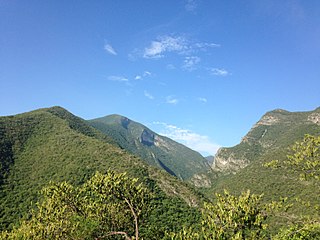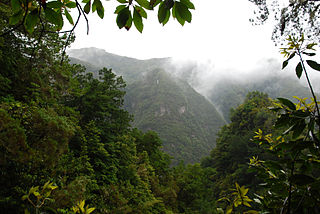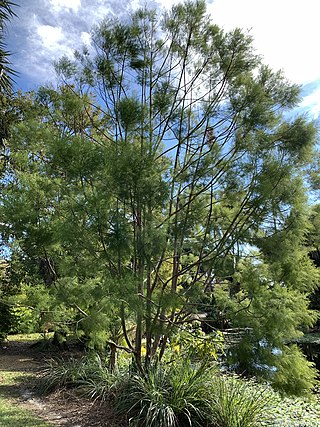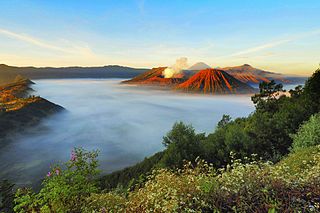
Sundaland is a biogeographical region of South-eastern Asia corresponding to a larger landmass that was exposed throughout the last 2.6 million years during periods when sea levels were lower. It includes Borneo, Java, and Sumatra in Indonesia, and their surrounding small islands, as well as the Malay Peninsula on the Asian mainland.

The Sierra Madre Oriental is a mountain range in northeastern Mexico. The Sierra Madre Oriental is part of the American Cordillera, a chain of mountain ranges (cordillera) that consists of an almost continuous sequence of mountain ranges that form the western "backbone" of North America, Central America, South America, and Antarctica.

Laurel forest, also called laurisilva or laurissilva, is a type of subtropical forest found in areas with high humidity and relatively stable, mild temperatures. The forest is characterized by broadleaf tree species with evergreen, glossy and elongated leaves, known as "laurophyll" or "lauroid". Plants from the laurel family (Lauraceae) may or may not be present, depending on the location.

Nepenthes rhombicaulis is a tropical pitcher plant endemic to Sumatra. The specific epithet rhombicaulis is formed from the Latin words rhombicus, meaning "rhomboid", and caulis, "stem". It refers to the cross-sectional shape of the stem internodes.

The Chin Hills-Arakan Yoma montane forests is a tropical and subtropical moist broadleaf forest ecoregion in western Myanmar (Burma). Surrounded at lower elevations by moist tropical forests, this ecoregion is home a diverse range of subtropical and temperate species, including many species characteristic of the Himalayas, as well as many endemic species.

The woodlands of the Iberian Peninsula are distinct ecosystems on the Iberian Peninsula. Although the various regions are each characterized by distinct vegetation, the borders between these regions are not clearly defined, and there are some similarities across the peninsula.

The Talamancan montane forests ecoregion, in the tropical moist broadleaf forest biome, are in montane Costa Rica and western Panama in Central America.

Anisoptera costata is an endangered species of plant in the family Dipterocarpaceae. The specific epithet costata means "ribbed", referring to the prominent venation of the leaf blade. A huge emergent tree up to 65 m high, it is found in evergreen and semi-evergreen lowland tropical seasonal forests of Indo-Burma and in mixed dipterocarp forests of Malesia.

Shorea leprosula is a species of tree in the family Dipterocarpaceae. It is native to Sumatra, Borneo, Peninsular Malaysia, Java, and Thailand.

Gymnostoma sumatranum is a tree in the she-oak family, Casuarinaceae, native to Southeast Asia and the Malesia region.

The island of Borneo is located on the Sunda Shelf, which is an extensive region in Southeast Asia of immense importance in terms of biodiversity, biogeography and phylogeography of fauna and flora that had attracted Alfred Russel Wallace and other biologists from all over the world.
Quercus iltisii is a species of oak tree native to western Mexico, where it is found in a small portion of Jalisco and Colima states.
Quercus semiserrata is an Asian species of trees in the beech family Fagaceae. It has been found in northeastern India, Bangladesh, Myanmar, Thailand, Yunnan, and Tibet. This species is a component of tropical wet foothill forests in northern Myanmar and can also be found in montane forests, often at elevations of 1200 - 1600 meters above sea level. It is placed in subgenus Cerris, section Cyclobalanopsis.
The Pine-oak forest of Puebla covers the mass of pine and oak forests in the Mexican state of Puebla.
Lithocarpus encleisacarpus is a tree in the beech family Fagaceae. The specific epithet is from the Greek meaning "enclosed fruit", referring to the acorns and cupules. The cupule is not fused to the nut though and often becomes irregularly dehiscent. The degree to which the nut is enclosed by the cupule varies across its geographic range. Trees in Lithocarpus are commonly known as the stone oaks and differ from Quercus primarily because they produce insect-pollinated flowers.

The Peninsular Malaysian montane rain forests is an ecoregion on Malay Peninsula. It occupies the mountainous spine of the peninsula in Malaysia and southernmost Thailand. It is in the tropical and subtropical moist broadleaf forests biome.

The Eastern Java–Bali montane rain forests ecoregion covers the higher altitude mountain rainforests on the eastern side of the island of Java, and most of the center of the island of Bali in Indonesia. The region has a number of active volcanoes, but is under pressure from growing human populations pushing into higher elevations and more marginal land. With elevations rising from sea level to 3,426 metres (11,240 ft), and precipitation varying between rainforest and drier forest levels, the area has many different forest types – evergreen, deciduous and semi-alpine.
Quercus lineata is a species of Quercus (oak) in the beech family Fagaceae, belonging to subgenus Cerris, section Cyclobalanopsis. It was first described by Carl Ludwig von Blume.












